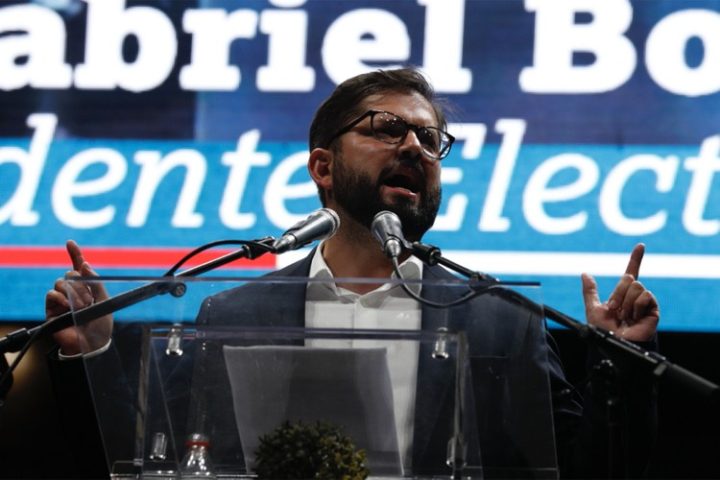
Santiago, Chile — On Sunday, December 19, the Marxist candidate, Gabriel Boric, won the Chilean elections defeating the more conservative José Antonio Kast. Thus, the board is set for the Revolution to continue and even to accelerate its pace in Chile. But, an important question is, did the majority of electors of this country really and consciously vote for the Revolution? The answer to this question is that it is unclear whether the majority really voted for it or not. Obviously, some did, but, did the majority vote for revolution?
First we observe: in the first round of the elections José Antonio Kast received more votes than any other candidate. The mainstream media, then, started a relentless campaign to present Boric as a moderate and Kast as an extremist. Thus, in this way, a big portion of the electors who voted for Boric in the run-off elections did it thinking that they were not voting for the revolution.
Secondly, I think that there are many signs that fraud occurred. Could there have been a fraud of such magnitude as to create a difference of 0.8 million votes? I do not know. Some say that it would be impossible to keep this hidden, which is judicious. However, (1) if the Chinese, Cuban, Venezuelan secret services are involved, as I suspect, I do not think this objection is final. We have to think on historical examples that prove that something similar is possible. When the Jesuits were expelled from the Spanish Empire (in 1767), a Empire where the sun did not set, nobody learned about that operation before it was executed, and it happened in the whole Empire the same day at the same time.1 And (2) it is possible that the actual difference in the certificates where the counting of votes is recorded in each voting location was not that big, but it was increased in the centralization process. The firm in charge of the centralization of data from the voting locations, Adexus, is said to be suspect and has been connected to some former scandals.2 So, I will develop my argument despite this objection.
Supposedly, in the run-off elections the number of voters was more than 1.2 million larger than in the first round of the elections, which was the largest turnout in Chilean electoral history by 1 million votes.3 But one did not see such turnout in the electoral centers. There was even a problem with public transportation in Santiago,4 which impeded many voters’ travel to voting locations.
Boric received in the run-off elections, according to the official data, more than 4.6 million votes. In the first round he got 1.8 million. If you gave him all the votes that the other leftist candidates scored on the first round, he could have reached only 3.2 million. If you add to this figure the 1.2 million of the excess of voters in the run-off, he still does not have the 4.6 million of the official results.
Kast, on the other hand, received in the run-off elections over 3.6 mllion votes –1.6 million more votes than in the first round. The electors who voted in the first round for another candidate but who naturally would transfer their votes to Kast in the run-off election were 1.7 million. Here the numbers square.
How could there be such a massive difference in Boric’s case? There is not and I think there will never be a final answer. The following, grounded in some evidence, are my guesses:
Chile has an excess of voters in the electoral registry. There were in 2017 at least 1.1 million more voters registered than persons with eligibility to vote5. This opens the possibility for the Office in charge of elections, the SERVEL, to maneuver.
In Chile, all voters have to produce their National Identification Document in order to vote. However, there is no system to prevent multiple voting. A voter could have other people’s identification documents and vote. There used to be a system to prevent multiple voting, which was the immersion of the little finger into a bottle of indelible ink. It was suppressed some years ago and no alternative system replaced it. You cannot be seen at a hospital, you cannot withdraw money from the Bank Office or enter some buildings in Chile without your identity being verified by a fingerprint match. For voting, however, there is no mechanism in place to prevent multiple voting. So, there is this huge gap in the electoral system. I have denounced this repeatedly and some Congressmen assured me that the gap was going to be filled, but it was not.6
Thus, my suspicion is that where José Antonio Kast had competent poll watchers, the revolutionaries sent people to physically go to the voting locations, show IDs and, masked as they were, cast votes for Boric. This was possible especially if the President or the Secretary of the voting point was in with the fraud. I, as a leader of poll watchers, saw several strange signs the day of the run-off elections. Many of the Presidents of the voting points along with even the SERVEL representatives were very hostile to Kast’s poll watchers. We had several conflictive situations. Moreover, although it is illegal to make pictures of the book where voters sign when they receive the ballot before marking and casting it, the Presidents of voting points had “smart watches” that would allow them to make videos of the book and send that information out. Many had those watches.
In Chile, the ballots have a tracking number so that when the voter comes back from the place where he secretly marks his preference, the personnel of the voting location can verify that the ballot is the same as that he was given. This is to prevent the situation in which the voters are given pre-filled ballots to cast in order to pressure them through a variety of tricks. Legally, these numbers have to be torn from the ballot right before casting it. But this time the personnel tore the identification numbers off of the ballots not after the ballot was marked and before casting it as the Law commands, but before giving it to the voters, and they tore off many of them at once. This opened room to casting votes while the poll watchers were absent for some reason. We, as poll watchers repeatedly complained about this but both the personnel of the voting locations and the liaison with the SERVEL were very aggressive in their purpose to continue this line of actions.
Moreover, in some cases the voters came and the box for the signature had been filled, so that they had to sign under the pre-existing signature, and so on.
There is harder evidence in one case. In Peñalolén, a university student was a poll watcher. This young man had doubts about the identity of one of the voters. He objected because his face was not similar to the ID picture and the signature was entirely different. The personnel of the voting point paid no attention to him and allowed this person to cast his vote. This happened three times. The fourth time, the poll watcher called the official of the Civil Registry (the government office in charge of citizens’ identification). He came, saw the discrepancy between the ID document and the face and signature – and yet, still allowed the person to cast his vote! At the end of the day, this official along with the employees of the SERVEL celebrated Boric’s victory. In many voting locations, the personnel asked the poll watchers to sit far from the point where IDs were verified with the excuse of the Covid situation.
Where Kast did not have poll watchers, I fear that the revolutionaries did whatever was necessary for their triumph. For example, they could just cast votes in the box and then sign randomly the empty spaces in the voters’ book.
Thus, I suspect that there were two coordinated actions: a micro-action in the voting centers whose goal was to cause the impression among the poll watchers that Boric effectively won. And a macro-action in which the centralization of data magnified the difference. With these two coordinated actions people are prone to think that such a huge fraud was impossible through multiple voting (and they are right) and conclude that therefore there was no fraud.7
My conclusion is that very probably there was fraud and that it was very professionally organized. So professionally organized that it would be impossible without the intervention of foreign powers. The only way to legally prove this fraud would be to perform an audit over a number of the voters’ books from the suspicious voting locations and check the signatures. But that is not going to happen, I am sure. Thus, Gabriel Boric becomes the President of Chile and the Revolution can be completed.
(Note: Gabriel Boric is scheduled to be inaugurated as President of Chile on March 11, 2022, taking over from the incumbent, President Sebastian Pinero.)
Dr. Carlos Casanova is a Professor of Law at the Pontifical University of Chile in Santiago. He has taught philosophy and law at other universities in Chile, as well as universities in the United States and Venezuela.
Related articles:
High Stakes Vote in Chile’s Dec. 19 Election
VIDEO: Communist Revolution Overthrowing Constitution in Once-Free Nation of Chile — Leah Southwell interview with Alex Newman, April 19, 2021
VIDEO: Communist Subversion of Chile & Venezuela — Prof. Carlos Casanova interview with Christian Gomez, November 19, 2019
Resurgent Communism in America
Footnotes:
1 See Marcelino Menéndez Pelayo, Historia de los heterodoxos españoles, chapter XXIII, section 3.
2 See https://www.tele13radio.cl/podcast/nativos/servel-y-conteo-de-votos-en-linea-la-empresa-adexus-es-la-encargada-del; and https://interferencia.cl/articulos/servel-paga-mas-de-700-millones-por-servicios-vinculados-al-plebiscito-firma-ligada
3 See http://www.plebiscitonacional2020.cl/plebiscito-nacional-2020-fue-la-mayor-votacion-de-la-historia-de-chile/. Chileans can easily remember the large voter turnouts for the referendum in October of 2020 and should realize that there were far more people voting that day than last Sunday which supposedly had a million people more than the referendum.
4 See https://www.youtube.com/watch?v=U9h1UXl5rS8, minute 28.
6 I know that for US standards the picture ID sounds sufficient. But it is not for Chileans. This is the reason why there used to be a system in order to prevent multiple voting.
7 A small piece of additional evidence is this: At 5:00 pm a popular TV channel, Tele 13 was broadcasting the election. At some point on the screen the public saw something very strange. An image quickly withdrawn according to which, after around 91% of the votes had been counted, Boric was winning 55.33% of the votes against 44.57% for Kast, which is very close to the final results announced by Servel later that night. This seems to be a fact, although it could have different interpretations. Some persons have guessed that perhaps those figures had to do with the voting process in foreign countries. It could be. But there was no sign indicating that and it is extremely coincidental that the final results are so similar (55.86 vs. 44.13).See https://www.youtube.com/watch?v=U9h1UXl5rS8, minute 26.
Related articles:
High Stakes Vote in Chile’s Dec. 19 Election



